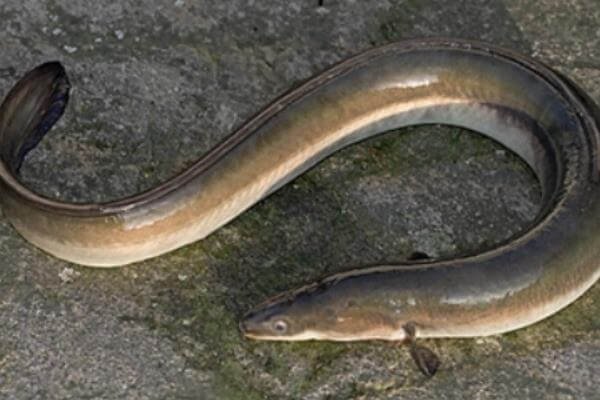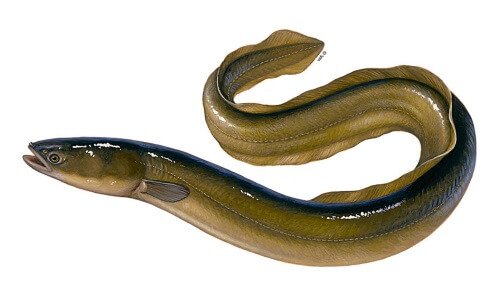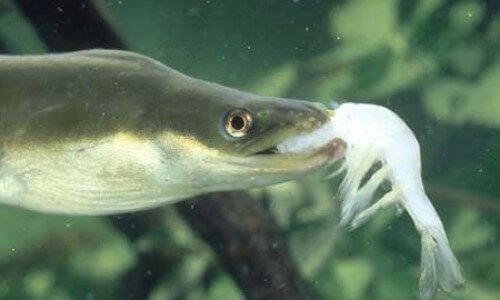The eel: characteristics, where they live, what they eat and species
The eel is an elongated fish, very similar to a snake, which has a surprising characteristic: it can live in rivers (fresh water) and in the sea (salt water). Also, as if that were not enough, you can even spend short periods of time on dry land. Therefore, it adapts perfectly to all types of habitats.
it is the only component of the order of the Anguiliformes, of the family of Anguilidae (Anguilidae). In the initial stage of his life he receives the name of Angula, and when he develops completely he changes his name.
 [Fuente]
[Fuente]
The shape of the body (morphology) of the eels is very interesting. Its body is elongated, as if it were a giant worm. The male specimens measure between 50 and 70 centimeters. On the other hand, the females, called heads, reach a greater length: between 1 and 2 meters.
The skin of these animals is stout and viscous, gray or greenish brown on the back, and yellowish or silvery on the belly. Your skin is covered with a kind of mucous substance that causes them to be very elusive.
 [Fuente]
[Fuente]
They also have scales, but they are extraordinarily small, almost microscopic. In the back of his head are born two fins that run through his body, one by the back and another by the belly, until they end up joining in the tail.
The lower jaw is somewhat more elongated and prominent than the upper jaw. The holes of the gills or gills are small. Now you know what the eel is like.
- What eels eat
Eels are omnivorous animals, that is, they eat everything, both plant substances and other animals. They eat mainly worms, molluscs, insect larvae, crustaceans, small fish and even some kind of tiny algae.
 [Fuente]
[Fuente]
When they go up the rivers, they are very voracious and are abundantly nourished by fish and their eggs, larvae and worms. In places where they finally stop, they specialize in catching fish and insects that live at the bottom of the water.
- Characteristics of the eel
These fish have an amazing ability to adapt to the habitat or environment in which they live. Mammals and birds have warm blood and stable temperature. In order to defend themselves from heat and cold, they must be protected, according to the species, by means of hair, feathers, fat under the skin (for example, the seal and the whale) and, in the case of man, with dresses of various kinds.
Fish, however, enjoy the ability to regulate the temperature of their body according to the heat of the water in which they are found. In short, if the water is cold, your body will also be cold. If the water is hot, the temperature of the fish will be high. These animals are called cold-blooded animals.
Naturally, its capacity for acclimatization has limits. Those who live in the salt water of the sea, say, would die in fresh water; the same would happen to those who live in a lake or river that goes to the sea.
Eels have gills instead of lungs. Through them they can pick up the oxygen they need to live from the water. If a fish is removed from its natural environment, it will surely die in a short time.
 [Fuente]
[Fuente]
But the eel is one of the few fish that does not have, or only in a small part, these limits. Indeed, it lives in both fresh and salt water, and is able to traverse, crawling, long stretches of completely dry land.
In terms of their life expectancy, usually lives about 12 years females and 9 years male.
- Eel species
To date, 21 different types of eels are known. We offer you a list with all of them:
- Anguilla, common eel or European eel (Anguilla anguilla)
- Short-finned anguilla (Anguilla bicolor bicolor)
- Giant spotted eel (Anguilla marmorata)
- Australian Anguilla (Anguilla australis australis)
- Long-finned eel of Africa (Anguilla mossambica)
- Indian Anguilla (Anguilla bengalensis bengalensis)
- African Spotted Anguilla (Anguilla bengalensis labiata)
- American Anguilla (Anguilla rostrata)
- Long-finned eel of Africa (Anguilla mossambica)
- Anguilla malgumora
- Anguilla bicolor pacifica
- Anguilla breviceps
- Anguilla australis schmidti
- Anguilla celebesensis
- Anguilla nebulosa
- Anguilla reinhardtii
- Anguilla dieffenbachii
- Anguilla interioris
- Anguilla nigricans
- Anguilla megastoma
- Anguilla obscura
There is a fish called the electric eel (Electrophorus electricus), but it belongs to the Gymnotidae family. It has the incredible ability to emit electric shock of up to 900 volts.
Use this feature to hunt their prey or defend against their predators. It is also known, depending on the country, by the names of shaker, pilaké, poraqué or temblón.
In the following video you can see how an electric eel defends itself from the attack of an alligator with a strong discharge. It is the nature law. Look at the tremors or spasms of the alligator until he dies:
In this profile we hope that this post titled What is the eel has been useful. If you want to see more similar articles or discover more curiosities and answers about my profile, you can visit the category of animals. Similarly, you can ask your questions directly in the comment that you leave, you will find below.
Hi, I just followed you :-) Follow back and we can help each other succeed! @mominulbd
ok